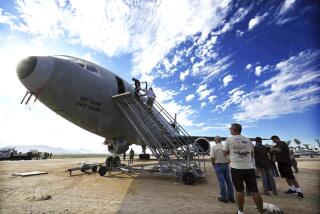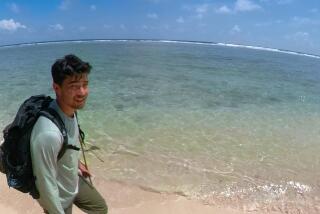U.S. Role in Peru Plane Downing Adds to Mystery
- Share via
LIMA, Peru — U.S. and Peruvian investigators Saturday were trying to unravel the perplexing circumstances in which an American missionary and her infant daughter died when a Peruvian air force anti-drug plane shot down their Cessna--an incident that also involved a U.S. surveillance aircraft.
As part of an anti-drug program in which U.S. aircraft help interdict smuggling flights, an unarmed U.S. surveillance plane was providing support Friday morning when the Peruvian A-37B jet shot down a private seaplane carrying five people, U.S. Embassy officials here revealed Saturday.
Baptist missionary Veronica Bowers and her 7-month-old daughter, Charity, died after being hit by gunfire. Their pilot was wounded in the legs and was in stable condition Saturday after being transferred from a jungle clinic to a hospital in the northern city of Iquitos.
“A U.S. government tracking aircraft was in the area in support of the Peruvian intercept mission,” an embassy spokesman said. “As part of an agreement between the U.S. and Peru, U.S. radar provides tracking information on planes suspected of smuggling illegal drugs in the region to the Peruvian air force. U.S. government tracking aircraft . . . do not participate in any way in the shooting down of suspect planes.”
The tragic and ironic elements of the case--an American mother and her baby blown out of the sky during a joint U.S.-Peruvian anti-drug operation--had U.S. investigators and consular officials scrambling Saturday. And the U.S. Embassy said further drug interdiction flights have been suspended, “pending a thorough investigation and review by Peruvian and U.S. officials of how this tragic incident took place.”
But the involvement of the U.S. surveillance plane, which was reportedly close enough for the Cessna’s pilot to see, underscored a fundamental question: What happened between the moment the anti-drug aircraft spotted the missionaries’ plane and the shoot-down itself?
The Cessna 185 seaplane was spotted about 10 a.m., and the shoot-down occurred about 11:20 a.m., according to the Peruvian government and informed sources. Peruvian air force officials insist that the missionary pilot, Kevin Donaldson, ignored radio warnings and other internationally established procedures with which the Peruvian pilot tried to contact him.
U.S. officials gave no signs Saturday that they doubted the Peruvian version. Yet it is hard to understand why Donaldson, a veteran missionary who grew up in Peru, would not comply with a Peruvian air force pilot.
Donaldson was flying over a jungle area rife with airborne border smugglers. His seaplane fit the profile of smuggling aircraft, which use clandestine landing strips and rivers to fly coca paste into neighboring Colombia and Brazil. The aggressive shoot-down policy of Peru’s air force, which has downed more than two dozen suspected drug flights since 1994, is well known.
The personnel on the U.S. surveillance plane could be an important source for answers because they probably saw and heard at least part of the interaction between the Peruvian pilot and the missionary pilot.
It is likely that the U.S. surveillance plane first identified the Cessna approaching from Brazilian airspace as a suspicious aircraft and alerted the Peruvian anti-drug plane, according to sources familiar with previous shoot-downs. Although U.S. officials would not comment on this case, they said that U.S. planes in the joint interdiction program use surveillance technology to pinpoint suspected smugglers for the Peruvian air force.
“U.S. government aircraft provide location data about aircraft flying in the region apparently without a flight plan,” a U.S. Embassy spokesman said. “The U.S. aircraft hands off this data to the Peruvian air force. Peruvian aircraft conduct the identification and interception missions.”
Acknowledging the gravity of the matter, President Bush took time out from the Summit of the Americas in Quebec City to say he planned to discuss the shoot-down with Peruvian Prime Minister Javier Perez de Cuellar.
“The United States is certainly upset by the fact that two citizens lost their lives,” Bush said. “I will wait to see all the facts before I reach any conclusions about blame.”
Facts were scarce Saturday because Peruvian government officials and the victims had little to say. Survivors James and Cory Bowers, the slain woman’s husband and 7-year-old son, were in Iquitos along with the wounded pilot, who was expected to be flown to Lima, the capital, on Saturday night. The bodies of the mother and daughter were also expected to be flown to Lima and probably on to the United States.
Donaldson’s wife, Bobbi, told Peruvian journalists Friday night that her husband had told her he saw a U.S. plane in the vicinity during the interception. She said the pilot said he had tried to communicate with his pursuer by radio and that he did not understand why the Peruvian anti-drug plane opened fire. But there were no further details to corroborate or refute that account Saturday.
Meanwhile, U.S. officials confirmed that, on the morning of the incident, the missionaries’ plane had been en route to Iquitos from Leticia, a Colombian town on the border with Brazil. The Bowers family, who lived in the Iquitos area, made the trip to Colombia to obtain a permanent Peruvian visa for the infant girl, a procedure requiring her to leave and reenter the country.
The Amazon area where Peru, Brazil and Colombia converge is notorious for drug trafficking and guerrilla activity. But the Bowerses were apparently unfazed by the dangers: They had lived in Peru since 1994, traveling by houseboat as missionaries for the Assn. of Baptists for World Evangelism.
In a news release Saturday, the Pennsylvania-based religious group asserted that its seaplane followed “all regulations, such as a flight plan, remaining in Peruvian airspace and maintaining contact with the flight towers. The plane had recently been refurbished and was in top condition and was well marked.”
Donaldson radioed the air traffic controllers in Iquitos just before 11 a.m., according to the news release. It was not clear how that call fit into the sequence of events, as described by the Peruvian air force, preceding the shooting.
After Veronica Bowers, known as Roni, and her baby were killed by bullets that tore through the fuselage, Donaldson was able to land the plane on a river and get the survivors out, according to the news release.
“They were rescued by a Peruvian in a dugout canoe and were taken to the clinic in the town of Pebas,” the press release said. “The Peruvian military, along with some U.S. personnel, evacuated Jim and Cory to Iquitos, along with the bodies of Roni and Charity.”
*
Times staff writer Rotella reported from Buenos Aires and special correspondent Tarnawiecki from Lima.
More to Read
Sign up for Essential California
The most important California stories and recommendations in your inbox every morning.
You may occasionally receive promotional content from the Los Angeles Times.










